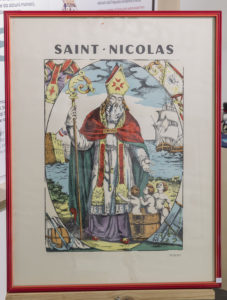
Poster in “Ti Ascolto”-Myrabilia Foundation
In July 2018 I published “The Best of Bari”. Six months later a new museum, known by its acronym “Munbam” which stands for the Children’s (Bambini) Museum of St. Nicholas, opened in the Norman Swabian Castle.
Much to the joy of all three generations of my family on a recent long weekend to Bari we discovered “Munbam”. This five-room inter-active museum for children is a rarity in Italy especially in the south.
First planned in 2014 and now administered by the Myrabilia Foundation, “Munbam” was designed by architect Antonella Mari. Its collection, curated by Marilena di Tursi, an art critic and contributor to Artribune, is displayed in five rooms. The first: “I listen to you” houses a library of “some 80 children’s books in English, French, Italian, Spanish, Dutch, German, Ukraine, Czech, and Polish, thanks to a recent school visit of children from there,” event-planner Gerardo Draetta, a founder, former President and now a Board Member of the Myrabilia Foundation told me. “They concern the saint’s life, miracles, and legends as well as the spread of his veneration across the world and transformation into Santa Claus.” A large wall map indicates the countries where St. Nicholas is revered: Argentina, Belgium, Croatia, Finland, France, Georgia, Germany, Hungary, Ireland, Italy Liechtenstein, Luxembourg, Poland, Rumania, Russia, Slovakia, Slovenia, Switzerland, Turkey (his birthplace), Ukraine, United Kingdom, and the United States.
Another wall panel tells anecdotes of the saint’s life using numbers. Two are the number of mouths on the flame of Unity in the crypt of St. Nicholas Basilica, symbols of ecumenism between the Catholic and Orthodox Churches. Three was the number of girls St. Nicholas saved from being sold into slavery as prostitutes when he secretly gave each one a bag of gold coins as a dowry. It’s also the number of ships with the 62 sailors that brought his relics from Myra to Bari. The sixth of December is the anniversary of St. Nicholas’s death and hence his Feast Day. The eighth and ninth of May are the dates the ships with his relics arrived in the port of San Giorgio and then in Bari.
A third wall panel, again featuring numbers, reports that St. Nicholas was born in 260 AD in Patara, now in Turkey, but then part of the Roman Empire where Greek was spoken. Born into a wealthy family, but soon orphaned, he inherited a large fortune, which enabled him to be so generous until his death in 337 AD. Iconographically-speaking he can be recognized thanks to four symbols: his bishop’s curved staff or crazier and his miter, the Book of the Gospels in his hand and the three gold balls at his feet which represent his generosity. Often also at his feet are three children in a vat. According to legend, St. Nicholas brought them back to life after an evil butcher had killed and pickled them.
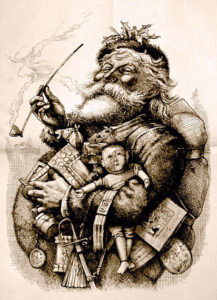
Nast’s cartoon
The third wall panel also reports three more modern dates concerning the transformation of the saint into Santa Claus: the 17th century when Dutch settlers brought St. Nicholas, the gift-bearer, to North America; In 1863 cartoonist Thomas Nast first depicted St. Nicholas as Santa Claus; and in 1931 graphic artist Haddon Sundblom created a bright red outfit for Nast’s Santa, who remained the figurehead of Coca Cola advertising until 1964.
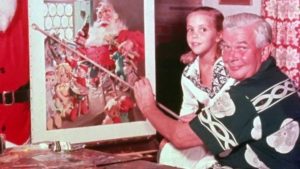
Haddon Sundblom at work-Coca Cola
The second room “I eat you”, decorated with baking utensils and Christmas dishes, concerns a few of the foods typically eaten at Christmas worldwide. Three foods: carp, carrots, and beer, are singled out here for their connection to the saint, who is the patron saint of brewers and distillers, bakers, brides, children, sailors and many others. According to legend, one of the three ships carrying his relics to Bari sprang a leak. In answer to the saint’s prayers a carp jammed itself into the hole in the keel and saved the sailors onboard. As for carrots, in northern Europe when St. Nicholas arrives on his feast day bearing gifts, children leave him a glass of milk and a carrot for his white horse or his donkey. “In Bari,” Draetta told me, “we typically celebrate St. Nicholas Day with sgaliozze (slices of fried polenta, sweet or salty, and cartellate, a rose-shaped paper-thin traditionally homemade fried pastry probably of Greek origin sweetened with honey accompanied by a hot chocolate after attending Mass in the Basilica.”
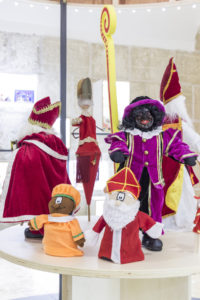
Toys in “Ti Gioco”-Myrabilia Foundation
In the third room “I play with you” visitors can enjoy thematic puppets, marionettes, dolls, games, puzzles and gadgets, while in “I write to you” they can read some of the thousands of letters the saint receives each year and a collection of thematic stamps. “I reinvent you” houses “Munbam’s creative laboratory, where young visitors can draw or write their personal impressions of St. Nicholas.
At “Munbam”’s entrance each child is given a passport, which must be stamped before entering each of the five rooms. “Mumbam” is open from 8:30 AM to 6:30 PM, but closed on Tuesday. Entrance to “Munbam” is included in the Castle’s ticket, but in the spirit of St. Nicholas, donations are appreciated.
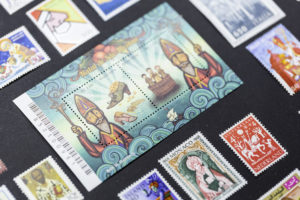
Stamps in “Ti Scrivo”-Mirabilia Foundation

Mail bags in “Ti Scrivo”-Mirabilia Foundation
The core collection of books and some 500 artifacts in “Munbam” come from private lenders and donors from all over Europe: the Franciscan archeologist, Byzantine scholar and prolific author from Bari Nino Lavermicocca, who died in 2014; the Chicago-born but longtime resident of England, the Reverend Canon James Rosenthal, who served many years as the Director of Communications for the Anglican Communion and editor of Anglican World; Swiss Hans Peter Rust, a freelance journalist and a biographer of the saint, who for the past some 40 years during Advent dresses up as St. Nicholas to visit poor families, daycare centers, schools and retirement homes as do Marcus Vankan, a Dutch priest in Heythuysen, and Belgian Marcel Janssens, who in 2011 made a some 1,600 mile two-month-long pilgrimage on foot from Liège to Bari. “Almost all our artifacts concern St. Nicholas and not Santa Claus,” said Draetta.
For a complete list of St. Nicholas museums, societies, and organizations click on www.stnicholascenter.org and then “Around the World”. In the United States there are three: The Knights of St. Nicholas in Crescent City, Illinois, The St. Nicholas Center for children at 2519 Ryan Street in Lake Charles, Louisiana and the St. Nicholas Center at 109 West 12th Street in Holland, Michigan, one of “Munbam”’s sponsors. Draetta pointed out to me that by clicking on the Center’s website and then on “Who is St. Nicholas?” followed by “Compare Santa and St. Nicholas”, there is a clear explanation of the differences between the saint and his 19th-century Anglo-American, consumer-driven counterpart Santa Claus, co-authored by Carol Meyer, the Center’s director and “Munbam” donor James Rosenthal.
Epilogue: According to an article published in 2017 in The National Geographic, “Where’s Santa Buried? Resting Places of the Real St. Nick”, it seems that, when the 62 sailors rescued St. Nicholas’s remains in 1087 from the Turkish invaders, they left some of his bones behind. They did so, not out of neglect, but out of reverence. Historically saints are considered miracle workers because God’s power and presence flows through them even after the saints’ mortal death. Hence the “forsaken” bones were unearthed in 1099 and taken to Venice were they are still conserved today in the Church of St. Nicholas on the Lido. Luigi Martino, a professor of anatomy at the University of Bari, performed scientific exams first in Bari during the 1950s and then in 1992 in Venice and concluded that the bones in both claimant cities came from the same skeleton.
Elsewhere, in Russia, France and Palestine, St. Nicholas’s alleged teeth and finger bones are cherished relics not to leave unmentioned New York City, specifically St. Nicholas Orthodox Church in lower Manhattan. It was destroyed during the collapse of the World Trade Center and its relics were never recovered. For further reading, aside from the books published by “Munbam”’s lenders/donors, consult The Saint Who Would Be Santa Claus” by Adam English.
Epilogue: As reported above the day before yesterday, December 6th, was St. Nicholas’s Feast Day. I was polishing my final paragraph about where to eat near “MunBam”, when my cellphone dinged a WhatsApp with the link to “Call it a Crime of Pasta”, by Jason Horowitz, Rome’s correspondent to the New York Times. In my earlier article about Bari, I had mentioned these enterprising ladies, who sell their orecchiette and cavatelli street-side to locals, tourists, and some of nearby restaurants, which I was about to recommend. Also know as Nicholas the Wonderworker, let’s hope he intercedes. After all, besides my above list of his protégés, he is also the patron saint of merchants, repentant thieves, and the hungry!
